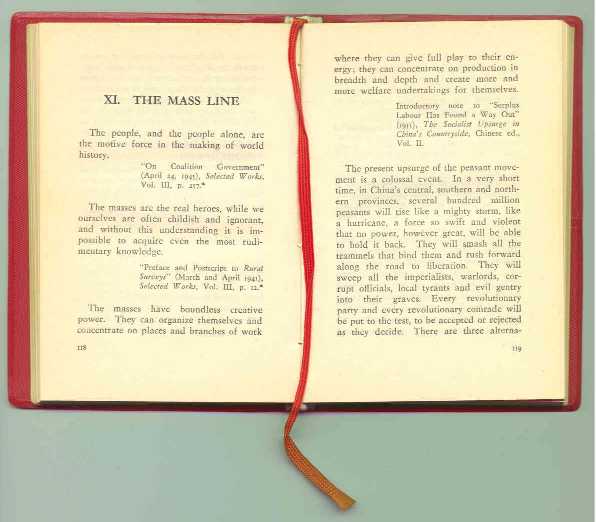The Mass Line and the American Revolutionary Movement
1. Introduction
When I first started talking about the mass line with my fellow fledgling revolutionaries half a century ago I was shocked by their responses. So superficial! So uniformed! So wildly mistaken in interpretation! (As if I myself knew so much!)
Most “60s revolutionaries” really did not take revolutionary theory seriously. There was an element of anti-intellectualism in the air in those days—which was probably understandable since there were few, if any, revolutionary intellectuals in this country who we could respect. Consequently there were Marxists who did not read Marx, Leninists who did not read Lenin, and Maoists who did not read Mao. Or at least not very much of them. Lin Biao was spouting his nonsense in China that it was only necessary for revolutionary students and workers to read a few short articles by Mao and memorize some quotes. Everything you needed to know was in the “Little Red Book”.[1] I love the “Little Red Book” myself and think it is well worthy of repeated study. But it is not the sum-total of Marxism. It is not even remotely close to being the sum-total of Mao’s thought.
All the 1960s radicals had heard about “the mass line”; phrases like that were bandied about constantly in those days. But very few people seriously investigated the subject. The mass line scholars of the day were those who had read section XI of the “Little Red Book”. So we had a situation where nobody had done much investigation of the subject, but everybody thought they knew what it was all about. Dangerous!

The “Red Book” (Quotations from Chairman Mao Tse-tung)
open to the section on the Mass Line
What most radicals of the 1960s and early 1970s thought the mass line was all about was what I would call populism; that the role of revolutionaries was to merge with the masses, learn from them, and join up with their struggles—and that’s all! Then in the mid and late 1970s there was a reaction against this view by those who took their Marxism more seriously, but unfortunately the baby seems to have been thrown out with the bath water.
It was not only American revolutionaries who were talking about the mass line, so were many bourgeois experts on China—the Sinologists. In my investigation of the mass line I looked through many dozens of books, pamphlets and articles on China, Chinese Communism and Mao Zedong to see what various authors have written about it. I found that nearly everyone mentions the subject and has at least a few words to say about it. But I also found that there exist very few discussions of the mass line that are at all extensive or thorough. Most authors evidently assume that the concept is simple and requires no long explication. At the same time I was struck by the diversity of interpretations of the mass line even among those who are sympathetic to the Chinese revolution (on the one hand), or among those who are antagonistic (on the other hand). This diversity of interpretation reinforced my view that the matter is not quite so simple as all these writers seem to think.
What apparently happens most frequently is that an author seizes on only a single aspect of the mass line and fails to recognize the existence of the other aspects. Among bourgeois scholars hostile to Mao and the Chinese revolution, for example, there are two main trends: 1) Those who see the mass line as a “populist” sort of concession to the wishes of the masses of people; and 2) Those who see the mass line as a big hoax, intended to fool the people into believing that the communist party and people’s government take the opinions of the masses into consideration when in fact they never deviate from their “communist dogma”. Neither of these views is even close to the truth. But the first view does correctly recognize that the mass line is not just window dressing, that the views of the masses are really listened to and made the basis for action—“at least sometimes”. On the other hand there is something to the second view too: it correctly recognizes that communist ideology is not sacrificed even in the face of opposition among the masses. But how both of these things could possibly be true is completely beyond the comprehension of bourgeois thinkers.
More or less the same divergence of interpretation of the mass line exists among those sympathetic to Mao’s China, and even within the communist movement itself. Revisionists and those who tend to make right opportunist errors usually see the mass line as an excuse for tailing after the spontaneous tendencies of the masses, while dogmatists and those who tend more often to make “left”-sectarian errors either ignore the mass line or treat it as a kind of gimmick or cover for the propagation of what communists “already know” to be the way forward. These opposite misconceptions will be explored in detail in the course of this essay.
It is in fact primarily for the purpose of exposing and attacking these two opposite distortions of the mass line within the revolutionary communist movement that this work has been written.